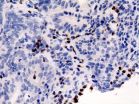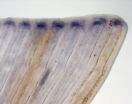(Press-News.org) VIDEO:
In this animated graphic of bats' calls in flight, two bats are represented by different colors, red and blue. The bats' movements and vocalizations have been slowed by a factor...
Click here for more information.
Look into the spring sky at dusk and you may see flitting groups of bats, gobbling up insect meals in an intricately choreographed aerial dance. It's well known that echolocation calls keep the bats from hitting trees and each other. But now scientists have learned some bats emit another call: one that tells their comrades to "back off" from bugs they've claimed for themselves.
Led by Biology Research Associate Genevieve Spanjer Wright, a five-person team from the University of Maryland found that male big brown bats can produce a special sound, called a "frequency-modulated bout" (FMB), that tells other bats with whom they are foraging to keep away from their prey. The Maryland researchers are the first to report this ultrasonic social call produced exclusively by flying, foraging male big brown bats. Their study, appearing in the March 31 issue of the Cell Press journal Current Biology, shows how important vocal social communication is for a nocturnal animal foraging with others of its species.
As the researchers examined audio recordings from two bats flying and foraging together, they noticed calls that seemed different from typical echolocation. To find out more, they analyzed video and audio recordings of bats' flight paths and calls, while male and female big brown bats flew alone and in pairs foraging for tethered mealworms. This led them to discover the special call they dubbed FMB.
The FMB is an ultrasonic social call that uniquely identifies the bat emitting it. It is a sequence of three to four sounds, longer in duration and lower in frequency than the typical echolocation pulses that big brown bats use to navigate. It is often followed by short buzz-like calls.
The researchers found the FMB increases the caller's success in snagging the insect for himself. After hearing the FMB, other bats increased their distance from the caller and moved away from the prey.
"When two males flew together in a trial, it was not uncommon for each bat to emit FMBs," says Wright. "We found that the bat emitting the greatest number of FMBs was more likely to capture the mealworm."
While some animals that forage in groups are known to emit calls to attract others towards food sources, the FMB is used to repel, not attract, other bats.
"Despite decades of study, many things about common bat behaviors such as foraging remain mysterious," says Wright. "We were able to study a social call that is likely occurring thousands of times a night all over North America during the summer months, yet had not been described or studied before now."
The researchers discovered only male big brown bats emitted the FMB, possibly to advertise their dominance or claim their territory. Female bats did not emit FMBs. That may be because females form close associations with their roost mates and may forage near familiar individuals, while males often roost alone or in small bachelor colonies and may be less familiar with others foraging nearby.
INFORMATION:
Working with Wright on the research were postdoctoral researcher Chen Chiu, research assistant Wei Xian, Biology Prof. Gerald Wilkinson, and Prof. Cynthia Moss of the Department of Psychology and the Institute for Systems Research. Future investigations will explore the potentially sophisticated nature and function of bat social calls.
This research was funded by the National Institutes of Health, and by a training grant from the National Institutes on Deafness and other Communication Disorders (NIH NIH R01-MH056366 and R01-EB004750; NID-NIDCD DC-00046.)Current
University of Maryland College of Computer, Mathematical and Natural Sciences
Media contacts:
Rebecca Copeland, 301-405-6602, rebeccac@umd.edu
Heather Dewar, 301-405-9267, hdewar@umd.edu
Current Biology article, "Social Calls Predict Foraging Success in Big Brown Bats" will be available after noon on Thursday, March 27 on the journal's website: http://www.cell.com/current-biology/
Contact Ms. Copeland or Ms. Dewar for an advance, embargoed copy of the article.
Foraging bats can warn each other away from their dinners
Male bats' 'back off' call discovered by Maryland researchers
2014-03-27
ELSE PRESS RELEASES FROM THIS DATE:
Researchers at IRB discover a key regulator of colon cancer
2014-03-27
Barcelona, Thursday 27 March 2014.- A team headed by Angel R. Nebreda at the Institute for Research in Biomedicine (IRB) identifies a dual role of the p38 protein in colon cancer. The study demonstrates that, on the one hand, p38 is important for the optimal maintenance of the epithelial barrier that protects the intestine against toxic agents, thus contributing to decreased tumour development. Intriguingly, on the other hand, once a tumour has formed, p38 is required for the survival and proliferation of colon cancer cells, thus favouring tumour growth. The study is published ...
Researchers: Biomarkers predict effectiveness of radiation treatments for cancer
2014-03-27
An international team of researchers, led by Beaumont Health System's Jan Akervall, M.D., Ph.D., looked at biomarkers to determine the effectiveness of radiation treatments for patients with squamous cell cancer of the head and neck. They identified two markers that were good at predicting a patient's resistance to radiation therapy. Their findings were published in the February issue of the European Journal of Cancer.
Explains Dr. Akervall, co-director, Head and Neck Cancer Multidisciplinary Clinic, Beaumont Hospital, Royal Oak, and clinical director of Beaumont's BioBank, ...
Cancer researchers find key protein link
2014-03-27
HOUSTON – (March 27, 2014) – A new understanding of proteins at the nexus of a cell's decision to survive or die has implications for researchers who study cancer and age-related diseases, according to biophysicists at the Rice University-based Center for Theoretical Biological Physics (CTBP).
Experiments and computer analysis of two key proteins revealed a previously unknown binding interface that could be addressed by medication. Results of the research appear this week in an open-source paper in the Proceedings of the National Academy of Sciences.
The proteins ...
Sleep may stop chronic pain sufferers from becoming 'zombies'
2014-03-27
Chronic pain sufferers could be kept physically active by improving the quality of their sleep, new research suggests.
The study by the University of Warwick's Department of Psychology, published in PLoS One, found that sleep was a worthy target for treating chronic pain and not only as an answer to pain-related insomnia.
"Engaging in physical activity is a key treatment process in pain management. Very often, clinicians would prescribe exercise classes, physiotherapy, walking and cycling programmes as part of the treatment, but who would like to engage in these activities ...
First sightings of solar flare phenomena confirm 3-D models of space weather
2014-03-27
Scientists have for the first time witnessed the mechanism behind explosive energy releases in the Sun's atmosphere, confirming new theories about how solar flares are created.
New footage put together by an international team led by University of Cambridge researchers shows how entangled magnetic field lines looping from the Sun's surface slip around each other and lead to an eruption 35 times the size of the Earth and an explosive release of magnetic energy into space.
The discoveries of a gigantic energy build-up bring us a step closer to predicting when and where ...
Corporate layoff strategies are increasing workplace gender and racial inequality
2014-03-27
Research from Prof. Alexandra Kalev of Tel Aviv University's Department of Sociology and Anthropology reveals that current workplace downsizing policies are reducing managerial diversity and increasing racial and gender inequalities. According to the study, layoff practices focusing on positions and tenure, rather than worker performance, minimized the share of white women in management positions by 25 percent and of black men by 20 percent. Prof. Kalev found that a striking two-thirds of the companies surveyed used tenure or position as their core criteria for downsizing. ...
Instituting a culture of professionalism
2014-03-27
Boston, MA—There is a growing recognition that in health care institutions where professionalism is not embraced and expectations of acceptable behaviors are not clear and enforced, an increase in medical errors and adverse events and a deterioration in safe working conditions can occur. In 2008 Brigham and Women's Hospital (BWH) created the Center for Professionalism and Peer Support (CPPS) and has seen tremendous success in this initiative. Researchers recently analyzed data from the CPPS from 2010 through 2013 and found that employees continue to turn to the center for ...
Controlling electron spins by light
2014-03-27
This news release is available in German.
The material class of topological insulators has been discovered a few years ago and displays amazing properties: In their inside, they behave electrically insulating but at their surface they form metallic, conducting states. The electron spin, i. e., their intrinsic angular momentum, is playing a decisive role. Their sense of rotation is directly coupled to their direction of movement. This coupling leads not only to a high stability of the metallic property but also enables a particularly lossless electrical conduction. ...
To grow or not to grow: a step forward in adult vertebrate tissue regeneration
2014-03-27
The reason why some animals can regenerate tissues after severe organ loss or amputation while others, such as humans, cannot renew some structures has always intrigued scientists. In a study now published in PLOS ONE*, a research group from Instituto Gulbenkian de Ciência (IGC, Portugal) led by Joaquín Rodríguez León provided new clues to solve this central question by investigating regeneration in an adult vertebrate model: the zebrafish. It was known that zebrafish is able to regenerate organs, and that electrical currents may play a role in this process, but the exact ...
Seasonal Arctic summer ice extent still hard to forecast, study says
2014-03-27
Scientists at the National Snow and Ice Data Centre (NSIDC), University College London, University of New Hampshire and University of Washington analysed 300 summer Arctic sea ice forecasts from 2008 to 2013 and found that forecasts are quite accurate when sea ice conditions are close to the downward trend that has been observed in Arctic sea ice for the last 30 years. However, forecasts are not so accurate when sea ice conditions are unusually higher or lower compared to this trend.
"We found that in years when the sea ice extent departed strongly from the trend, such ...
LAST 30 PRESS RELEASES:
Numbers in our sights affect how we perceive space
SIMJ announces global collaborative book project in commemoration of its 75th anniversary
Air pollution exposure and birth weight
Obstructive sleep apnea risk and mental health conditions among older adults
How talking slows eye movements behind the wheel
The Ceramic Society of Japan’s Oxoate Ceramics Research Association launches new international book project
Heart-brain connection: international study reveals the role of the vagus nerve in keeping the heart young
Researchers identify Rb1 as a predictive biomarker for a new therapeutic strategy in some breast cancers
Survey reveals ethical gaps slowing AI adoption in pediatric surgery
Stimulant ADHD medications work differently than thought
AI overestimates how smart people are, according to HSE economists
HSE researchers create genome-wide map of quadruplexes
Scientists boost cell "powerhouses" to burn more calories
Automatic label checking: The missing step in making reliable medical AI
Low daily alcohol intake linked to 50% heightened mouth cancer risk in India
American Meteorological Society announces Rick Spinrad as 2026 President-Elect
Biomass-based carbon capture spotlighted in newly released global climate webinar recording
Illuminating invisible nano pollutants: advanced bioimaging tracks the full journey of emerging nanoscale contaminants in living systems
How does age affect recovery from spinal cord injury?
Novel AI tool offers prognosis for patients with head and neck cancer
Fathers’ microplastic exposure tied to their children’s metabolic problems
Research validates laboratory model for studying high-grade serous ovarian cancer
SIR 2026 delivers transformative breakthroughs in minimally invasive medicine to improve patient care
Stem Cell Reports most downloaded papers of 2025 highlight the breadth and impact of stem cell research
Oxford-led study estimates NHS spends around 3% of its primary and secondary care budget on the health impacts of heat and cold in England
A researcher’s long quest leads to a smart composite breakthrough
Urban wild bees act as “microbial sensors” of city health.
New study finds where you live affects recovery after a hip fracture
Forecasting the impact of fully automated vehicle adoption on US road traffic injuries
Alcohol-related hospitalizations from 2016 to 2022
[Press-News.org] Foraging bats can warn each other away from their dinnersMale bats' 'back off' call discovered by Maryland researchers







